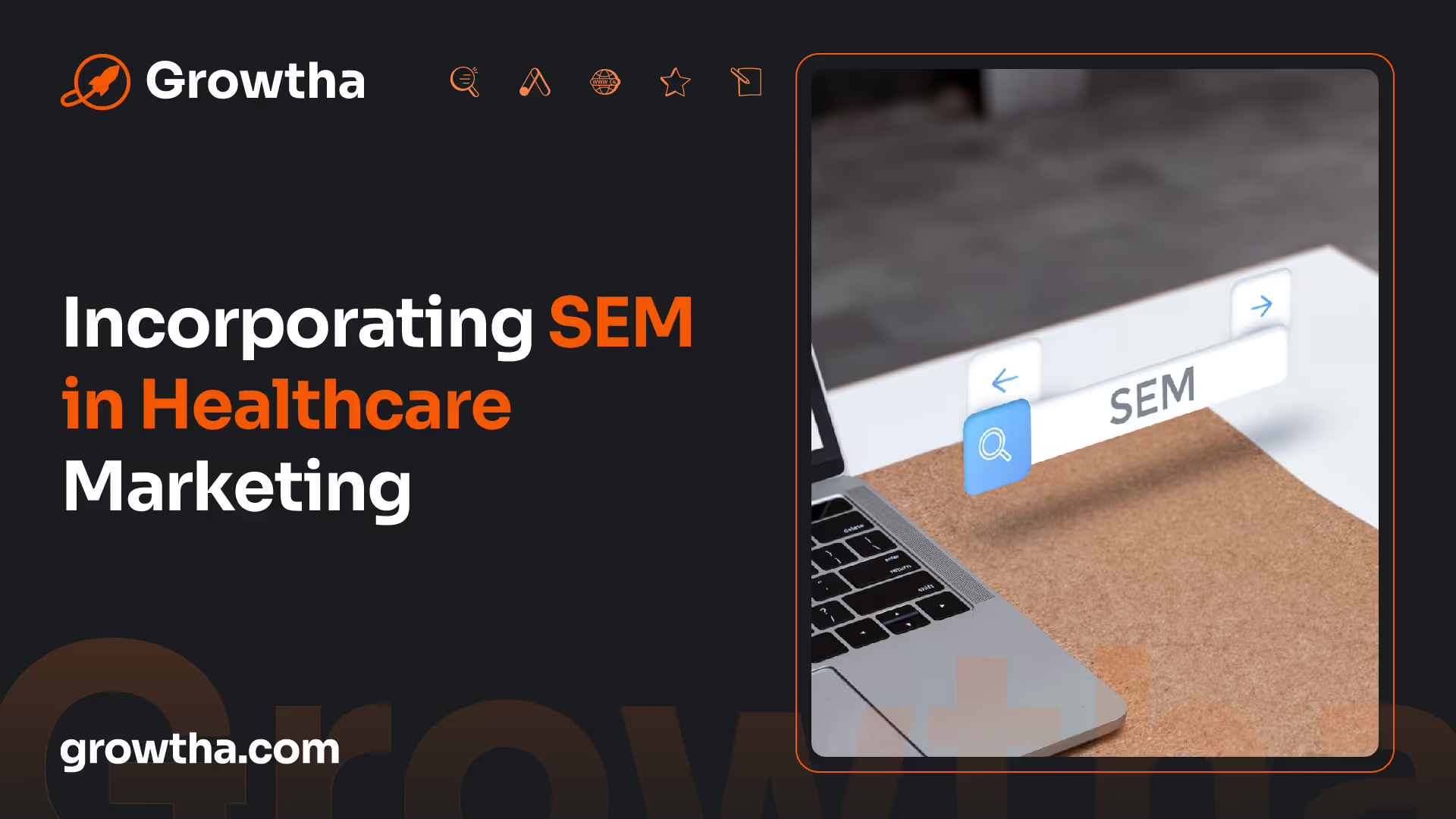SEO vs. SEM for Healthcare: Understanding the Key Differences
SEO for healthcare involves optimizing a healthcare facility's online presence to increase visibility on search engine results pages (SERPs) and attract relevant traffic.


SEO vs. SEM for Healthcare: Understanding the Key Differences
Understanding SEO for Healthcare
In the digital age, healthcare organizations are recognizing the importance of search engine optimization (SEO) in their marketing strategies. SEO for healthcare involves optimizing a healthcare facility's online presence to increase visibility on search engine results pages (SERPs) and attract relevant traffic. Let's explore the importance of healthcare SEO and the key elements involved.
Importance of Healthcare SEO
Healthcare SEO plays a vital role in the online success of healthcare organizations. By ranking well on SERPs for relevant search queries, healthcare websites can increase their online visibility and drive more traffic. This increased visibility leads to more clicks, which can result in generating leads and attracting new patients at a lower cost compared to running ads [1].
Additionally, healthcare SEO helps educate potential and current patients by providing valuable and informative content. By establishing your facility as an authoritative source of healthcare information, you build trust and credibility with your audience.
Elements of Healthcare SEO
To implement effective healthcare SEO strategies, there are several key elements to consider. These elements include:
- Content Optimization: Creating high-quality and informative content is crucial for healthcare SEO. Optimizing headlines, images, and HTML tags with relevant keywords helps search engines understand the content and improves your website's search engine rankings.
- Keyword Research: Conducting thorough keyword research allows you to identify the search terms and phrases that your target audience is using. By integrating these keywords strategically throughout your website's content, you can increase the chances of appearing in relevant search results [2].
- Backlinks and Online Mentions: Encouraging positive online mentions and acquiring backlinks from reputable healthcare websites can enhance your website's authority and credibility in the eyes of search engines. This can positively impact your search engine rankings and attract consistent, relevant leads for your healthcare practice [2].
By understanding the importance of healthcare SEO and implementing these key elements, healthcare organizations can improve their online visibility, attract more traffic, and establish themselves as trusted sources of healthcare information.

Incorporating SEM in Healthcare Marketing
In the ever-evolving landscape of healthcare marketing, incorporating SEM (Search Engine Marketing) is essential for reaching the target audience effectively. SEM encompasses various strategies that utilize paid advertising to generate visibility through search engines like Google, Bing, and Yahoo. By combining both SEO and PPC (Pay-Per-Click), SEM provides immediate impact through paid search results and long-term visibility through organic strategies [3].
SEM Strategies for Healthcare
When it comes to healthcare marketing, implementing SEM strategies can significantly enhance visibility and drive targeted traffic to healthcare websites. Some common SEM strategies employed in the healthcare industry include:
- PPC (Pay-Per-Click) Advertising: PPC enables healthcare providers to bid on relevant keywords and display their ads at the top of the search engine results page. This immediate visibility helps drive traffic to their websites and increase brand exposure.
- Local Search Ads: Local search ads allow healthcare providers to target users searching for services in their specific geographic area. These ads appear prominently in local search results, making it easier for potential patients to find and connect with healthcare providers nearby.
- Display Advertising: Display advertising involves placing visual ads on relevant websites or social media platforms. Healthcare providers can leverage display ads to increase brand awareness and target specific demographics.
- Shopping or Product Advertising: For healthcare providers offering products such as medical devices or wellness products, shopping or product ads can be effective in reaching potential customers. These ads showcase specific products along with relevant information and pricing details.
- Remarketing: Remarketing allows healthcare providers to target users who have previously visited their website but did not convert. By displaying targeted ads to these users as they browse other websites, healthcare providers can encourage them to return and take the desired action.
Benefits of SEM in Healthcare
Incorporating SEM in healthcare marketing offers numerous benefits for healthcare providers. Some key advantages include:
- Comprehensive Search Visibility: SEM, when combined with SEO, improves overall search visibility by utilizing both paid and organic strategies. This ensures that healthcare providers appear in search results across various channels, maximizing their online presence.
- Faster Results: Unlike organic SEO efforts that can take time to yield results, SEM provides immediate visibility through paid search results. This allows healthcare providers to quickly reach their target audience and drive traffic to their websites.
- Data Synergy and Insights: SEM provides valuable data and insights on user behavior, search trends, and campaign performance. This data can be used to refine marketing strategies and optimize future campaigns for better results.
- Increased Click-Through Rates (CTR): SEM strategies, such as PPC advertising, often result in higher click-through rates compared to organic search results. This increased CTR can lead to more website visits and potential patient conversions.
- Strong Brand Presence: With SEM, healthcare providers can create a strong brand presence by appearing prominently in search engine results. This helps build trust and recognition among potential patients, increasing the likelihood of them choosing the healthcare provider's services.
- Maximized Keyword Coverage: By leveraging both organic SEO and paid search strategies, healthcare providers can maximize their keyword coverage. This ensures that they are visible to potential patients searching for relevant healthcare services or information.
Incorporating SEM into healthcare marketing strategies allows healthcare providers to expand their reach, enhance visibility, and drive targeted traffic to their websites. By capitalizing on the benefits of SEM, healthcare providers can effectively connect with their target audience and achieve their marketing goals.

Differentiating SEO and SEM
In the realm of healthcare marketing, it's important to understand the key differences between SEO (Search Engine Optimization) and SEM (Search Engine Marketing). While both strategies aim to improve online visibility, they have distinct goals and components.
Different Goals of SEO and SEM
SEO primarily focuses on optimizing a website to rank higher in organic search results. The goal is to increase organic traffic and improve the website's visibility without relying on paid advertising. The core objective of SEO is to enhance the website's relevance and authority, making it more likely to appear prominently when users search for relevant healthcare-related keywords.
On the other hand, SEM encompasses both paid and organic strategies to drive traffic and visibility. It includes SEO as well as paid search advertising, commonly known as PPC (Pay-Per-Click). The goal of SEM is to maximize online visibility by combining organic efforts with paid advertisements. PPC allows healthcare providers to bid on specific keywords and display ads in search engine results, driving immediate traffic to their websites.
Key Components of SEO vs. SEM
SEO and SEM have different components that contribute to their effectiveness in healthcare marketing.
SEO Components
- Keyword Research and Optimization: Conducting thorough keyword research to identify relevant keywords and strategically optimizing website content, meta tags, and headings to improve organic rankings.
- On-Page Optimization: Optimizing website elements such as page titles, URLs, internal linking, and image alt tags to enhance user experience and search engine crawlability.
- Content Development: Creating high-quality, informative, and engaging content that answers users' queries and positions the website as a trustworthy resource.
- Link Building: Acquiring relevant and authoritative backlinks from reputable websites to boost the website's credibility and organic rankings.
- Technical SEO: Optimizing technical aspects of the website, such as site speed, mobile responsiveness, and structured data markup, to improve user experience and search engine visibility.
SEM Components
- PPC Advertising: Running targeted ad campaigns through platforms like Google Ads, bidding on specific keywords, and displaying ads in search engine results.
- Keyword Bidding and Budgeting: Setting bids for keywords and managing budget allocation to maximize the effectiveness of paid advertising.
- Ad Copy Creation: Crafting compelling and relevant ad copies that entice users to click on the advertisements.
- Landing Page Optimization: Designing and optimizing landing pages to align with the ad copy and provide a seamless user experience.
- Campaign Tracking and Analysis: Monitoring and analyzing campaign performance, making data-driven adjustments to optimize ROI and enhance campaign effectiveness.
Understanding the differences between SEO and SEM can help healthcare providers make informed decisions about their marketing strategies. While SEO is a long-term investment that focuses on organic visibility, SEM combines organic efforts with paid advertising to drive immediate results. The choice between the two depends on various factors such as budget, goals, immediate needs, and available opportunities.
Maximizing Healthcare Visibility
When it comes to maximizing visibility in the healthcare industry, two key aspects of SEO come into play: local SEO for healthcare providers and technical SEO best practices. Let's explore each of these components in detail.
Local SEO for Healthcare Providers
For healthcare providers, local SEO is crucial in reaching potential patients in their immediate area. In fact, 46% of all Google searches seek local information [4]. Optimizing your content with local keywords can significantly improve your visibility in local search results, ensuring that your medical practice stands out to those searching for healthcare services nearby.
Local SEO not only attracts more local patients but also enhances the user experience on your website. By providing essential information such as operating hours, location, and available services, you can improve the overall user experience and make it easier for potential patients to find the information they need [5].
Technical SEO Best Practices
Technical SEO plays a vital role in healthcare marketing by improving the technical elements of your website to achieve better search engine rankings. By optimizing various technical aspects, you can enhance your website's relevance and quality for specific search terms, providing a solid foundation for a successful SEO campaign [6].
Some technical SEO best practices include:
- Optimizing website speed to ensure quick loading times, as slow-loading websites can negatively impact user experience and search engine rankings.
- Implementing proper website structure and organization, including clear navigation and well-defined URLs, to make it easier for search engines to crawl and understand your website's content.
- Ensuring mobile-friendliness, as an increasing number of users access the internet through mobile devices, and search engines prioritize mobile-friendly websites.
- Implementing schema markup to provide search engines with additional information about your website's content, enabling them to display rich snippets in search results.
By incorporating these technical SEO best practices, you can improve your website's organic search visibility, making it easier for potential patients to find the information they need and ultimately driving more traffic to your healthcare website.
Maximizing healthcare visibility requires a comprehensive approach that includes both local SEO and technical SEO. By optimizing your website for local searches and implementing technical SEO best practices, you can increase your online visibility and attract more potential patients to your healthcare practice.
Strategies for Effective Healthcare Marketing
To achieve success in healthcare marketing, it's essential to implement effective strategies that maximize visibility and reach the intended audience. Two key strategies to consider are content marketing and keyword research and implementation.
Content Marketing for Healthcare
Content marketing plays a crucial role in healthcare marketing by enabling brands to connect and engage with patients through high-quality, relevant, and valuable content. By delivering actual, valuable content to readers, healthcare content marketing offers key benefits such as improving search rankings and establishing trust and credibility with the target audience [6].
When executing a content marketing strategy, it's important to produce content that is informative, engaging, and tailored to the needs and interests of your target audience. This can include blog articles, videos, infographics, and social media posts. By consistently publishing valuable content, you can establish your healthcare brand as a trusted source of information and build lasting relationships with patients.
Keyword Research and Implementation
An effective SEO strategy starts with keyword research, allowing you to identify and target relevant keywords for your healthcare marketing campaign. This process helps you determine the keywords and phrases that patients use when searching for medical services or specialties. By incorporating these keywords strategically into your website content, you can improve your search rankings for those terms and increase organic traffic to your site [6].
To conduct keyword research, utilize keyword research tools to identify popular and relevant keywords in your industry. Focus on long-tail keywords that are specific to your healthcare services and have a higher likelihood of converting visitors into patients. Once you have identified the target keywords, incorporate them naturally into your website content, including page titles, headings, meta descriptions, and body text.
Remember, effective keyword implementation involves striking a balance between optimizing your content for search engines and ensuring it provides valuable information to your audience. Avoid keyword stuffing or using irrelevant keywords, as this can negatively impact user experience and search engine rankings.
By implementing content marketing strategies and conducting thorough keyword research, healthcare providers can enhance their online visibility, attract more patients, and establish themselves as authoritative sources in their respective fields. These strategies, when executed effectively, contribute to a comprehensive healthcare marketing approach that drives growth and success.
References
[1]: https://www.linkedin.com/pulse/complete-playbook-healthcare-seo-flying-v-group
[2]: https://www.semrush.com/blog/healthcare-seo/
[3]: https://localiq.com/blog/seo-vs-sem/
[4]: https://www.linkedin.com/pulse/3-core-components-strong-healthcare-seo-strategy-digitalismedical
[5]: https://www.linkedin.com/pulse/5-benefits-local-seo-medical-professionals-digitalismedical
[6]: https://www.cardinaldigitalmarketing.com/healthcare-resources/blog/seo-guide-fundamentals-for-growth/







